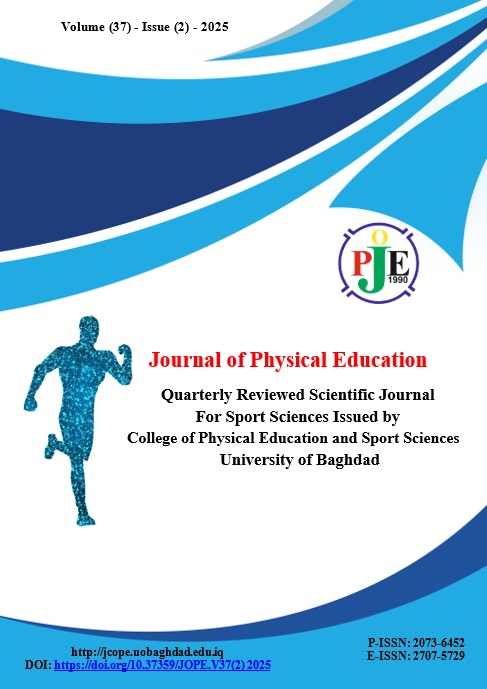The Effect of Specialized Exercises Based on Mechanical Principles on Diagonal Attacks from Positions (2) and (4) Among Third-Year Students in Volleyball
DOI:
https://doi.org/10.37359/JOPE.V37(2)2025.2208Keywords:
Mechanical principles, Diagonal attack, VolleyballAbstract
Researchers and specialists in the fields of educational sciences strive to enhance the academic level of their students. Among the most prominent of these sciences is sports science, which encompasses various specializations, curricula, and theories. This has driven professionals in this field to constantly seek the most effective, shortest, and simplest ways to achieve high-quality outcomes through experimentation and practical application. The aim of this research was to develop specialized exercises based on mechanical principles for diagonal attacks from positions (2) and (4) among third-year volleyball students. The study also aimed to determine whether these exercises are more effective than conventional training in influencing the targeted research variables. The researchers employed an experimental approach involving both a control and an experimental group, using pre- and post-tests. Two specific tests were administered, focusing on diagonal attacking skills from positions (2) and (4). The research sample consisted of 12 third-year students from the Department of Physical Education and Sports Sciences at Al-Farahidi University (academic year 2024–2025), who were deliberately selected as top-performing students and divided into two groups (experimental and control), each comprising six students. The SPSS statistical software package was used to analyze the results. After presenting and discussing the results, the study concluded that there was a statistically significant improvement in both groups between the pre- and post-tests. Additionally, a significant difference was found in favor of the experimental group in the post-tests. The researchers recommend the adoption of these exercises due to their significant effectiveness.
References
Ahmed Ameen Akour. (2000). Kinematic analysis and its relationship with the accuracy of the volleyball spike in both low and high types. Master’s thesis, University of Baghdad, College of Physical Education.
Alaa Mohsen Yasser. (2007). Comparison of some biomechanical variables in high front and back setting skills from standing and jumping in volleyball. Ph.D. thesis, College of Physical Education, University of Baghdad.
Ali Mustafa Taha. (1999). Volleyball – History – Education – Training – Analysis – Rules. Cairo: Helwan University, Dar Al-Fikr Al-Arabi.
Aws Saadoun & Mohammed Saleh. (April 28, 2020). The strategy of electronic concept maps and its effect on the cognitive achievement of some technical volleyball skills. https://jcope.uobaghdad.edu.iq/index.php/jcope/article/view/9, pp. 9–41.
Ban Faisal Al-Azzawi. (2014). Quantitative analysis of some biomechanical variables and accuracy and speed of serving and spiking skills in volleyball. Unpublished Master’s thesis, University of Baghdad – College of Physical Education and Sport Sciences for Women.
Crosiers, J. L., & Others. (2005). Factors correlated with volleyball spike. American Journal of Sports Medicine.
Dhafer Al-Kadhimi & Mazen Al-Taie. (2012). Tennis – Technical preparation and tactical performance (education – development – training – rules). Najaf: Dar Al-Dhiaa.
Dhafer Hashem Al-Kadhimi. (2012). Practical applications for writing educational and psychological theses and dissertations. Baghdad: University of Baghdad.
Fadel, G. A., & Kadem, M. J. (2021). Youth and Sports Forums’ Administration and Their Relationship with Baghdad’s Youth and Sport Directorates Forum Organizational Culture from Workers’ Point of View. Journal of Physical Education, 33(3).
Hamed Youssef Hameed. (2001). A study of some biomechanical variables during the take-off phase and their relation to high jump performance (Fosbury Flop). Unpublished Ph.D. thesis, University of Baghdad – College of Physical Education.
Issa, F. A. W., Mohaif, S. M., & Kadhim, M. J. (2024). The effect of functional strength training according to gradually increasing load in developing some physical abilities and achievement for men’s 100-meter competition runners. Journal of Physical Education, 36(2).
Kadhim, M. J. (2023). Examining The Relationship Between Social Classes And The Culture Of Poverty: A Case Study. International Journal of Social Trends, 1(1), 23–27.
Kadhim, M. J. (2024). Social Networks’ Place in Contemporary Political Movements. International Journal of Social Trends, 2(2), 51–59.
Kadhim, M. J., Shihab, G. M., & Zaqair, A. A. (2021). The Effect of Using Fast And Direct Cooling after Physical Effort on Some Physiological Variables of Advanced Football Players. Annals of the Romanian Society for Cell Biology, 25(6), 10014–10020.
Khader Abbas, I., Mushref, A., & Ameen, M. J. (2024). The effect of corrective exercises accompanied by mechanical feedback on some kinematic indicators and learning how to perform volleyball spiking for students. Journal of Studies and Research in Physical Education, 34(3), 342–360. https://doi.org/10.55998/jsrse.v34i3.691
Maher Amer & Riyadh Khalil. (September 28, 2022). The effect of the Jigsaw strategy on learning the volleyball spiking skill among second-year students. https://jcope.uobaghdad.edu.iq/index.php/jcope/article/view/13, pp. 34–522.
Mahmoud Dawood Al-Rubaie & Others. (1999). Theories and methods of physical education. Baghdad: Directorate of Book Printing and Publishing.
Qasim Hassan Hussein & Iman Shakir. (1998). Research methods in biomechanics. Amman: Dar Al-Fikr Al-Arabi.
Raad Khamees & Hussein Subhan. (September 28, 2019). The effect of special exercises using some educational aids in learning basic volleyball skills for first intermediate students. https://jcope.uobaghdad.edu.iq/index.php, pp. 9–32.
Rola Miqdad Obaid. (Vol. 5, No. 2, 2006). The effect of cooperative learning on acquiring some offensive skills in fencing. Journal of Physical Education Sciences, University of Babylon, p. 12.
Saad Mohsen Ismail. (1996). The effect of training methods for developing explosive power of the legs and arms on the accuracy of high jump shooting in handball. Ph.D. thesis, University of Baghdad, College of Physical Education.
Saad Nafe & Waleed Ghanem. (Vol. 9, No. 3, 2009). A study on the accuracy of volleyball spiking and its relationship with some kinematic variables. Al-Qadisiyah Journal for Physical Education Sciences.
Sheikh Ali, H. F., & Qasim, M. A. (2024, March 15). The effectiveness of mastery learning style in developing skill performance in volleyball among students. Journal of Studies and Research in Physical Education, 34(2), 129–146. https://doi.org/10.55998/jsrse.v34i2.498
Suleiman Ali Hassan & Others. (1980). Track and field competitions. Egypt: Dar Al-Maaref.
Talha Hossam Al-Din. (2014). Basics of movement sciences: Descriptive and functional kinesiology. Cairo: Modern Book Center, 1st ed.
Vandalen. (1985). Research methods in education and psychology (Translation: Mohammed Nabil and others). Cairo: Anglo Egyptian Bookshop.
Yaareb Abdul-Baqi Dayekh. (September 15, 2021). A comparative analytical study of the maximum height reached by the center of mass in flight and at the moment of executing the main phase in jump shot skills in handball and volleyball spiking and serving. Journal of Studies and Research in Physical Education, 31(3), 123–132. https://jsrse.edu.iq/index.php/home/article/view/112
Downloads
Published
Issue
Section
License
Copyright (c) 2025 Journal of Physical Education

This work is licensed under a Creative Commons Attribution-NonCommercial 4.0 International License.






 The Journal of Physical Education (JOPE) applies a Creative Commons Attribution 4.0 International license (CC BY 4.0), which lets others distribute, remix, tweak, and build upon your work, even commercially, as long as they credit you for the original creation. For more information, click the link :
The Journal of Physical Education (JOPE) applies a Creative Commons Attribution 4.0 International license (CC BY 4.0), which lets others distribute, remix, tweak, and build upon your work, even commercially, as long as they credit you for the original creation. For more information, click the link : 